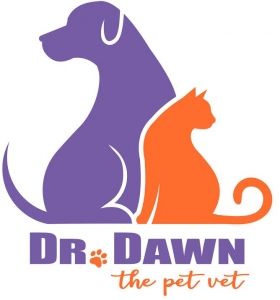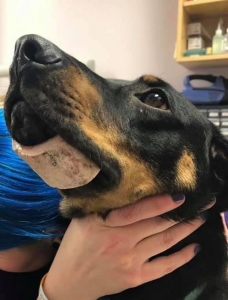Few subjects are more controversial, in the dog world, than whether or not to feed dogs bones. If so, which ones are safe, which are not, which ones cause choking, which do not, which do you recommend…. This is a topic which I find people ask me about, more often because they have formed their own opinions, and want to hear if I am in their “camp” or not.
You can find, on Dr. Google, blogs and articles galore to back up any theory you might have about, virtually anything. I am well aware that, if my answer is not what someone believes, I am over… at least in their eyes. I no longer have any credibility at that point, in their minds. In the words of Lionel Ritchie, “I can see it in ‘their’ eyes, I can feel it in ‘their (fake)’ smile”. I may have solved the greatest medical mystery, or known their dog from puppyhood, but one wrong comment on this polarizing subject, and stick a fork in me because I am DONE.
Having just had a conversation about this with my own mother, I have been prompted/urged to address this subject publicly. For the reasons outlined above, I have mainly skirted around this issue. My typical responses to clients go something like this:
“You want to know what makes veterinarians lots of money. Surgeries that deal with removing (fill in the blank) from dog intestines.”
Or, “You know what keeps veterinarians very busy? Rawhide. Surgeries to remove it, medication and hospitalization to deal with the consequences of it. Time spent Googling carpet cleaners, installers, and reupholsters to recommend to clients after they have purchased it. Bacon flavor coated? Even better. Oh, and here’s where you can get your own Little Green Machine carpet cleaner. No, don’t bother renting them. Just go ahead and buy one, as it will save you money in the long run.
And, mostly: “Here’s a list of things I DON”T give my dog: rawhide, raw bones, cooked bones,doggie breath mints, tug toys to crank on her neck with, old shoes, jerky treats, hot dogs, leftovers like steak, etc, on top of her food, corn on the cob, toys that she can easily chew apart into nice choking hazard pieces”… You can choose to do the same, and I recommend that you do, but I am fully aware that you may or may not take my advice. Just because I have seen bad things happen, it doesn’t mean that it will happen with your dog. It just means that it COULD happen. But why risk it? Why not choose from countless other options that are less likely to cause problems.
Then there is the other type of client. The one who asks me to recommend things that could never possibly cause a problem, or become a choking hazard. My mother falls into this camp. This is where a brief anatomy lesson is in order.
I tried to find a better, simpler picture of the area where the entrance to the esophagus (and ultimately stomach) crosses over with the area where things can accidentally get into the lungs. What is important is that there is a little flap of tissue that acts as a protective gate for the windpipe, while we swallow. This is not a big area that we are talking about, and in a teeny tiny poodle, maltese, or other toy breed, it doesn’t take much to block this area, and cause a dog to choke. I don’t say this to alarm you and cause you to go out and buy a Ninja blender to pulverize your dog’s food into a smoothie. I am just saying that common sense, and avoiding things that can lodge or crack off easily, such as splintering bones, is a good idea.

Personally I give my dog greenies. I do so, because I watch her when she eats them, and she does so slowly. I also prefer to be around when I do give her one. If your dog cracks them in half immediately, you may not want to offer them.
 I also love CET chews. They soften with the dog’s saliva and therefore get nibbled on slowly. Can’t crack them easily. They help their teeth.
I also love CET chews. They soften with the dog’s saliva and therefore get nibbled on slowly. Can’t crack them easily. They help their teeth.
 I am a big fan of Kong toys. They come in various sizes, and most dogs are unable to bite through them. There are various treats that are sold that you can fill them with (like peanut butter), or you can fill them yourself with soft cream cheese. Entertains your dog for a while and their tongues get a workout trying to get to that last bit of stuff near the tip. I have yet to see a dog whose tongue got caught in one. Again, select the correct size for your dog wisely. A giant dog could swallow the little ones.
I am a big fan of Kong toys. They come in various sizes, and most dogs are unable to bite through them. There are various treats that are sold that you can fill them with (like peanut butter), or you can fill them yourself with soft cream cheese. Entertains your dog for a while and their tongues get a workout trying to get to that last bit of stuff near the tip. I have yet to see a dog whose tongue got caught in one. Again, select the correct size for your dog wisely. A giant dog could swallow the little ones.
I feed my dog NEITHER raw nor cooked bones, with or without meat on them. The argument for feeding bones I often hear is that that they are natural and healthy for dogs, typically accompanied by a report of the nutritional value of bones. There are lots of natural things in nature that can also kill your dog. Wolves and wild dogs eat them all the time. Sure, but do you know the lifespans and causes of death of wolves and wild dogs? Bones are said to promote clean teeth, which is true, but at what cost? No one is stopping you from brushing their teeth. Chicken bones can splinter, and become lodged in the throat, perforate intestines, etc. People believe that cooking bones makes them more likely to splinter. I have seen cooked and uncooked cause serious problems. Large round bones, like cow knuckle bones, can crack off and obstruct, and can result in teeth cracking. Raw bones with meat also can carry bacteria such as salmonella and e-coli, and have short shelf lives.
So, for all it’s worth, these are my thoughts. I urge you to use common sense when choosing treats for your dogs. I think of it this way…there are so many unforeseen dangers out there for dogs. You can’t possibly avoid all of them. But, why not avoid the ones you have control over?
Dr. Dawn
Please share and subscribe here









